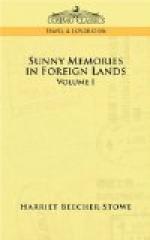May 5. Well, we saw the Dulwich Gallery; five rooms filled with old masters, Murillos, Claudes, Rubens, Salvator Rosas, Titians, Cuyps, Vandykes, and all the rest of them; probably not the best specimens of any one of them, but good enough to begin with. C. and I took different courses. I said to him, “Now choose nine pictures simply by your eye, and see how far its untaught guidance will bring you within the canons of criticism.” When he had gone through all the rooms and marked his pictures, we found he had selected two by Rubens, two by Vandyke, one by Salvator Rosa, three by Murillo, and one by Titian. Pretty successful that, was it not, for a first essay? We then took the catalogue, and selected all the pictures of each artist one after another, in order to get an idea of the style of each. I had a great curiosity to see Claude Lorraine’s, remembering the poetical things that had been said and sung of him. I thought I would see if I could distinguish them by my eye without looking at the catalogue I found I could do so. I knew them by a certain misty quality in the atmosphere. I was disappointed in them, very much. Certainly, they were good paintings; I had nothing to object to them, but I profanely thought I had seen pictures by modern landscape painters as far excelling them as a brilliant morning excels a cool, gray day. Very likely the fault was all in me, but I could not help it; so I tried the Murillos. There was a Virgin and Child, with clouds around them. The virgin was a very pretty girl, such as you may see by the dozen in any boarding school, and the child was a pretty child. Call it the young mother and son, and it is a very pretty picture; but call it Mary and the infant Jesus, and it is an utter failure. Not such was the Jewish princess, the inspired poetess and priestess, the chosen of God among all women.
It seems to me that painting is poetry expressing itself by lines and colors instead of words; therefore there are two things to be considered in every picture: first, the quality of the idea expressed, and second, the quality of the language in which it is expressed. Now, with regard to the first, I hold that every person of cultivated taste is as good a judge of painting as of poetry. The second, which relates to the mode of expressing the conception, including drawing and coloring, with all their secrets, requires more study, and here our untaught perceptions must sometimes yield to the judgment of artists. My first question, then, when I look at the work of an artist, is, What sort of a mind has this man? What has he to say? And then I consider, How does he say it?




